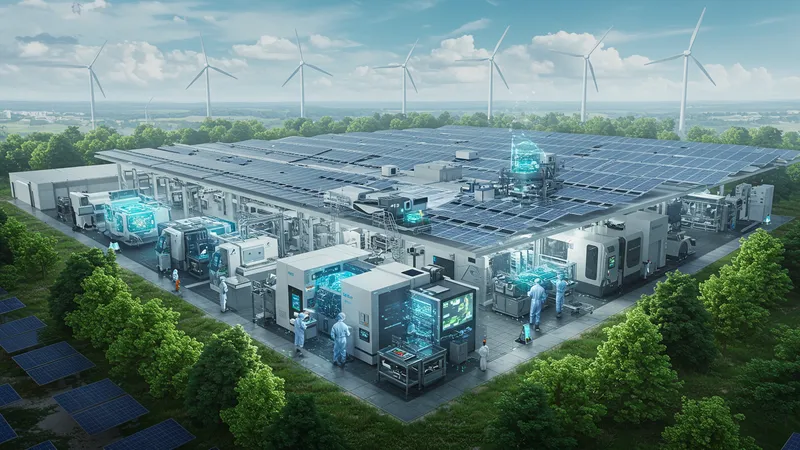Did you know that the future of semiconductors is green? Yes, it’s true! Sustainability is revolutionizing chip manufacturing in ways you never imagined.
As global demand for electronics soars, the race to produce eco-friendly semiconductors has reached a fever pitch. This movement isn't just a trend; it's a necessity. But what’s pushing tech giants to go green right now?

In an industry infamous for its massive carbon footprint, companies are embracing unexpected green innovations that defy conventional wisdom. For instance, some are implementing novel water recycling systems that save millions of gallons annually. But that’s not even the wildest part...
The true shocker? Advanced organic semiconductors are set to outperform traditional silicon chips, offering both environmental and performance benefits. This radical development could dethrone industry giants almost overnight. But that’s not even the tip of the iceberg...
Curious about what’s driving these seismic shifts? Prepare to be amazed as we uncover more shocking truths that even the experts didn’t see coming...
The semiconductor industry has long thrived on rapid innovation and growth. But what happens when this growth becomes unsustainable? With mounting pressure from governments and activists, embracing sustainability is not just a choice—it's a mandate now. What's shocking is how quickly companies are adapting, turning sustainability into a competitive advantage.

Major players are integrating eco-friendly processes at unprecedented rates. An Intel plant recently achieved zero waste, a concept once viewed as impossible for such high-tech production, highlighting that sustainable practices can coexist with technological advances. But there’s a hidden element to this drive...
Internal studies have shown that improving sustainability can also drive down operational costs significantly. For instance, by switching to renewable energy sources, companies report saving millions annually. Yet, the true benefits go beyond mere cost-cutting...
What you read next might change how you see this forever. The relentless pursuit for greener semiconductors holds fascinating consequences that are reshaping our world for the better.
Beyond environmental impact, companies adopting green technologies are reaping hidden benefits. It turns out, sustainable practices can drastically increase employee satisfaction and retention. Workers feel more valued working for companies with a strong ethical stance, enriching corporate culture profoundly.

There’s also a consumer demand angle—environmentally conscious consumers are increasingly favoring brands that prioritize sustainability. Companies like Apple have capitalized on this trend, seeing it as a way to reinforce brand loyalty. But there's another layer that's often unnoticed...
Adopting sustainable practices has led to unexpected alliances across industries. Tech companies now collaborate with renewable energy firms, cross-pollinating innovations that spearhead faster advancements. However, that barely scratches the surface of what’s possible...
Brace yourself as you delve further into these interconnected developments. The implications are far-reaching, predicting a future that is astonishingly different from the present.
One of the most exciting breakthroughs is utilizing biodegradable materials for semiconductor manufacturing. These cutting-edge materials promise to reduce waste significantly, offering a more sustainable lifecycle for electronic devices.

Furthermore, technologies like quantum tunneling hold promise for reducing energy consumption in semiconductor production, offering a win-win for both the environment and efficiency. Yet, these breakthroughs are just the beginning of a deepening trend...
Research facilities across the globe report finding success with low-energy fabrication techniques that drastically cut the carbon footprint. Universities and private labs are leading the charge, creating ripples of innovation beyond the industry itself.
What comes next will redefine our approach to technology. Stay tuned as we explore the ramifications of these transformative innovations and how they spell a greener future for all.
As the sector trends towards sustainability, cooperation becomes vital. Competitors surprisingly unite over sustainable goals, realizing that ecological advancements benefit the entire ecosystem. These partnerships often accelerate technological progress.

Leading tech companies and environmental NGOs are working hand in hand, sharing resources and insights that drive sustainable developments faster than individual efforts. The results have been astounding, but there are hidden complexities...
Cross-industry partnerships sometimes lead to knowledge and technology exchange that propels unimagined innovations. However, navigating these novel alliances can be tricky, often involving complex negotiations that might stumble upon unforeseen roadblocks.
But there's another dimension to these partnerships. They hint at a mindset shift within the industry that might just revolutionize our tech landscape moving forward. Keep reading as we unravel this fascinating transformation.
Legislation plays a crucial role in nudging the semiconductor industry towards sustainability. New policies mandate reduced emissions and encourage the adoption of renewable energies through incentives and tax benefits.

These governmental frameworks drive firms to outpace each other in adopting environmentally friendly practices. Although regulatory landscapes differ across continents, their collective aim remains the same: minimize environmental impact.
Compliance often requires firms to overhaul long-standing processes—a challenging but necessary shift. Yet, these changes bring unexpected dividends, stimulating local economies through job creation in the sustainability sector.
The next chapters will delve into how these policies catalyze industry transformation and the surprising outcomes that even seasoned policymakers couldn't foresee. Stay with us!
Consumer awareness is shifting industry paradigms, with a growing segment demanding transparency and environmental responsibility. This consumer activism pressures brands to disclose their sustainability efforts.

Companies that align with these values experience enhanced brand perception and loyalty. Notably, eco-friendly product lines record skyrocketing sales figures, reshaping product development priorities.
However, navigating consumer expectations can be complex. Brands must balance innovation, cost, and sustainability without compromising on quality—an intricate dance that, if done right, leads to excelling market positions.
Continuing this journey, the next chapter investigates consumer influence in reshaping technological advances, offering a glimpse into a future marked by their active role.
Sustainability certifications are emerging as crucial credentials in the tech world. These certifications, such as Energy Star and EPEAT, are fast becoming industry standards.

Achieving these certifications offers firms a competitive edge, attracting conscious consumers and validating their commitment to green practices. But achieving them demands rigorous compliance and verification processes.
Interestingly, the pursuit of certifications often reveals areas of enhancement that companies otherwise overlook. This continuous improvement cycle is fostering a culture of excellence in sustainability.
What you’re about to learn might challenge how these certifications fit into the larger picture of sustainability. Don’t miss it!
The green wave is sweeping through supply chains. From resource extraction to finished goods, the emphasis on sustainable practices rejuvenates the industry’s commitment to environmental stewardship.

Supply chain transparency is evolving, with companies tracking environmental impacts along every step. Emerging technologies such as blockchain play a pivotal role in this transparency, providing an unexposed layer of accountability.
This transparency enables firms to identify inefficiencies and expedite sustainable resource management strategies, adding to overall operational efficiency and reducing environmental footprints.
The following sections promise deeper insights into the significance of these innovations, unveiling a transformative perspective on supply chain durability and sustainability.
Transitioning to sustainable practices isn’t without challenges. High initial costs, the need for new infrastructure, and resistance to change pose significant hurdles that companies must surmount.

Yet, those who navigate these barriers strategically position themselves as future leaders against competitors still clinging to outdated methods. It’s a complex journey multitudinous with both pitfalls and potential.
Surprisingly, these challenges are acting as catalysts for innovation rather than roadblocks. Firms are investing in breakthrough technologies, poised to change the landscape radically.
Read on to uncover contrarian insights into how these difficulties drive creativity and redefine success in the semiconductor industry.
What does the future hold for semiconductors in a world where sustainability is prioritized? Predicting advancements points to a fascinating fusion of technology and ecology.

From harnessing alternative energy sources in production, to recycling and recovering metals at the end of the product lifecycle, the trends suggest a more symbiotic relationship between tech advancement and ecological balance.
However, looming geopolitical tensions and resource scarcity may impede progress. Yet, these challenges may expedite innovation and collaboration, igniting unforeseen opportunities.
The narrative ahead explores potential outcomes, sparking considerations that promise to redefine the semiconductor industry’s trajectory. Join us as we venture forward.
The ripple effects of eco-focused semiconductor production extend beyond the industry. Sustainability efforts boost local economies, foster new green jobs, and inspire educational programs dedicated to environmental technology.

Communities around manufacturing hubs witness improved quality of life due to reduced pollution and innovative waste management practices. Yet, there's another dimension to these societal benefits...
Tackling sustainability galvanizes a generational shift in attitudes towards consumption and technology, creating global environmental awareness. It’s a cultural evolution that academics and anthropologists find fascinating.
Don’t miss the surprises in upcoming pages that examine these broader impacts, illuminating unanswered questions about the green revolution's role in shaping a sustainable society.
Sustainability tales from established leaders beautifully illustrate the power of vision-driven strategies implemented at scale. Trailblazers such as Google and Microsoft continue to excel, promoting innovative ecological practices.

Through their pioneering actions, they inspire startups and younger professionals to link success with environmental consciousness, fostering a promising new generation of eco-entrepreneurs.
Their stories reveal blueprints that can be replicated across sectors beyond tech, leading to global sustainable progress. The strategic insights gleaned from their experiences are invaluable.
The pages that follow detail inspiring anecdotes and golden nuggets of wisdom that provoke introspection and motivate action, positively impacting the industry.
Success in the semiconductor industry is being redefined, with sustainability as a central pillar. Where growth alone once marked success, ecological health now shares the spotlight.

Balanced value propositions that integrate environmental stewardship, combined with technological innovation, are redefining corporate objectives and outlines new metrics for achievement.
This shifting landscape beckons a holistic view—one where triple-bottom-line accounting takes precedence, proving that success rooted in sustainability is viable and profitable.
Ahead, we distill profound lessons that urge organizations to evolve beyond traditional measures of success, offering rich takeaways for forward-thinking entities.
As we stand on the cusp of a green semiconductor revolution, bold predictions loom large. Industry veterans foresee advancements that are likely to reshape conventional norms fundamentally.

Localized production facilities, leaner supply chains, and modular designs hint at the sophisticated and sustainable future of semiconductors. The visions these predictions inspire are expansive.
However, navigating this future requires resilience to ambiguity and uncertainty—an adaptive mindset that’s prepared for dynamic growth and change.
The final pages unearth these predictions and galvanize your imagination, captivating your senses with a vivid portrayal of what's to come in the semiconductors' sustainable evolution.
The green revolution in semiconductors is not merely a passing fad but a transformative force with enduring impact. As chip manufacturers embrace sustainability, they not only steward the planet but also unlock new vistas for innovation and growth.
To witness this unfolding story, we invite you to share these revelations with others who may find value in understanding the paradigm shift towards sustainability. Bookmark this evolving narrative, and be a part of the movement for a greener future in technology.